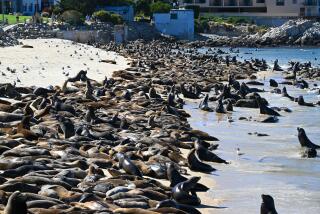Nesting Areas Take a Tern for the Worse
OXNARD — Just when you thought it was safe to walk on the beach, the California least terns are on the move.
They’re not going far, mind you. But the endangered shore birds--with the white bellies, bright yellow beaks and distinctive black hoods--have jumped their protective compound at Ormond Beach and are nesting this summer along a wider stretch of the white sand floor.
While the development may be just a natural consequence of a growing population, it is an alarming trend for those who have fought to pluck the species from the brink of extinction.
Too much human intrusion can frighten off an entire colony, driving the terns to abandon their nests and their eggs.
Scrambling to keep the flock flourishing, volunteers over the weekend expanded the protective boundary, erecting about 500 feet of chain-link and hundreds of signs warning beach-goers to steer clear of the breeding grounds.
And with the Fourth of July holiday approaching, state fish and game officials are waging an extensive public relations campaign to keep intruders away from the summer colony--one of only three major colonies along the Southern California coast.
“I don’t know that people realize that there is a species out here that is struggling to survive,” said Jamie Jackson, a least tern monitor for the state Department of Fish and Game.
“This is not a small beach, it’s a big beach,” she added, patrolling the nesting grounds Monday afternoon. “Basically, all the terns are asking for is this dunes area, and only four months out of the year.”
Compared to the turn of the century, when the birds were hunted almost to extinction for their feathers, the colony at Ormond beach is thriving now. So far during this nesting season--which runs from about mid-May to mid-September--Jackson has counted 83 active nests and as many as 175 adult terns.
The terns are feisty and protective of their young. Visitors to the breeding ground, between Point Mugu and the Port Hueneme fishing pier, are met by squadrons of dive-bombing terns, squawking their displeasure at the intrusion.
“They want us to scram,” said Jackson as the birds flew up from their nests, dug out of the sand and made a beeline for her head. “They’re very aggressive, but they need to be.”
That is because there are numerous threats to the population, Jackson and others say.
Predators such as gulls, foxes and coyotes feed on the eggs. People or dogs can unwittingly trample a least tern nest while walking along that stretch of beach. But perhaps the biggest threat comes from off-road vehicle enthusiasts, who illegally plow the dunes on motorcycles or dune buggies.
A gate erected across a dirt road intended to keep vehicles out doesn’t work anymore after it was smashed to pieces by someone intent on driving on the dunes. The area now guarded by chain-link is crisscrossed by tire tracks from off-road vehicles.
Some of the warning signs--alerting the public that the nesting site is a state and federally protected area--were used last week by vandals for a bonfire.
“It’s pretty amazing how often people will read a sign and just ignore it,” said Al Sanders, who as conservation chairman for the Sespe group of Los Padres Chapter of the Sierra Club has been battling to protect the terns for seven years.
“It’s good that we’re having more success and that we’ve got more terns down there than in previous years,” Sanders said. “But they are creating a lot of work for us.”
Ultimately, officials and environmentalists hope the extended fencing and a stepped-up campaign to alert the public about the problem will spare more nests from being trampled.
But just to be safe, volunteers and fish and game officials will patrol the area during the Fourth of July holiday, looking for people who are disturbing the breeding grounds.
“It gets a little better every year,” Jackson said. “But it’s still a big problem, and there’s still a long way to go before it’s solved.”
More to Read
Sign up for Essential California
The most important California stories and recommendations in your inbox every morning.
You may occasionally receive promotional content from the Los Angeles Times.










